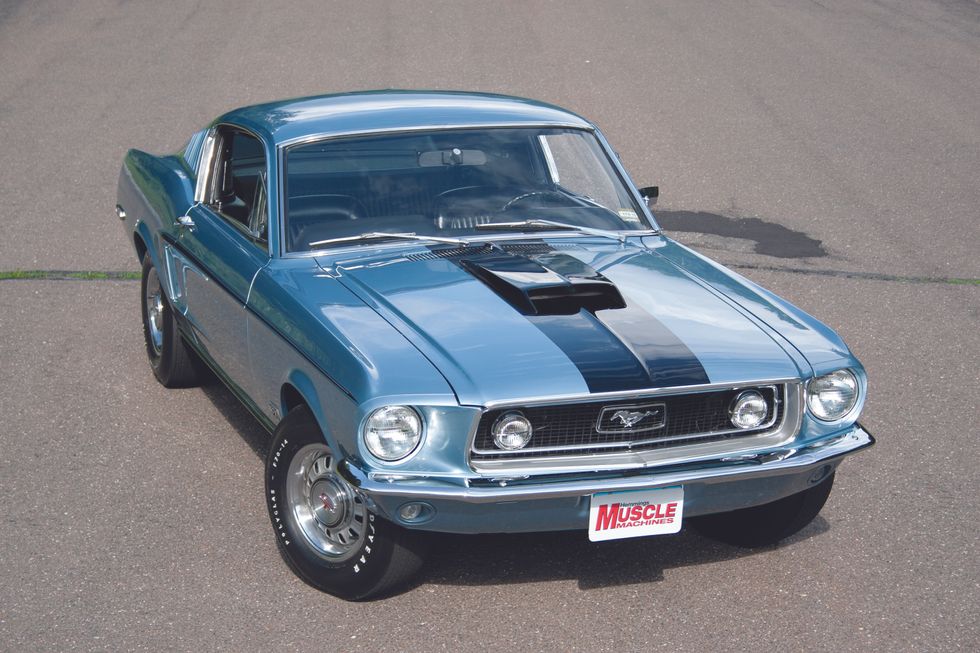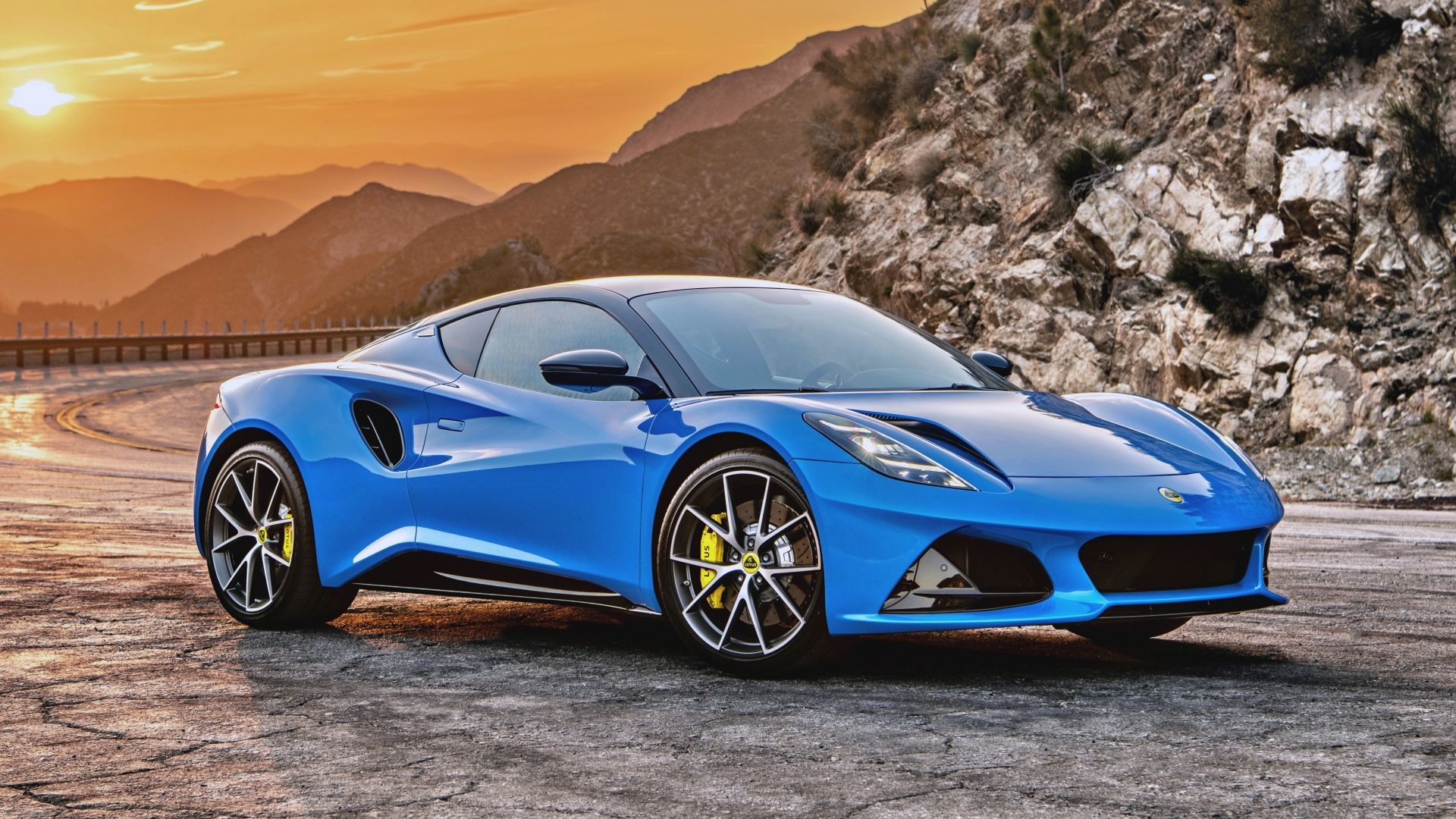
HOW THE 428 COBRA JET ENGINE RESCUED THE MUSTANG'S PERFORMANCE IMAGE
The redesigned ’67 Mustang was drop-dead gorgeous: racier, more refined and oozing European grand touring flair — particularly the fastback. Its engine bay was widened to accommodate Ford’s FE engines and, for ’67, the 4V 390 got the nod as the top offering.
This should’ve made the Mustang a rolling embodiment of Ford's “Total Performance” image – the image Dearborn cultivated with full-page ads and race wins on the world’s biggest stages. But the 390 fell short on the “performance” part of Total Performance — at least when squaring off against big-block Mopars and GM cars.
This didn’t sit well with the Blue Oval loyalists — chief among them Bob Tasca Sr. of Tasca Ford, in East Providence, Rhode Island. Tasca Ford was profiting on the youth performance market and it was also one of the nation’s highest-volume Ford dealers. So when Tasca complained about the 390 and demanded more — Ford listened.
The howling, all-conquering FE 427 was ruled out as being too expensive and too difficult to produce in mass quantities for the Mustang. Next in line was the 428: a proven passenger car engine that could perhaps be modified to outperform the 390. Soon after ’67 Mustangs hit showrooms, Ford began work on a 428 that could take on the competition and would become iconic among Blue Oval fans: the Cobra Jet.
Photo: Matt Litwin
Ford engineers revised the 428 engine block for added strength,and stabbed in the 390 GT hydraulic camshaft —as a more aggressive cam would’ve failed emissions requirements. This new 428’s cylinder heads were a free-breathing design based around 427 cylinder heads designed for use in 1968 427 Cougars. The iron intake and exhaust manifolds were unique as was the 735-cfm Holley carburetor. By mid-’67, the 428 “Cobra Jet” had advanced to the testing stage and Ford engineers liked what they saw.
The 428 Cobra Jet program wasn’t public knowledge but the idea of dropping a hopped-up 428 into a Mustang received some national publicity in the November 1967 issue of Hot Rod Magazine. Editor Eric Dahlquist wrote a feature story about a 428 that Tasca Ford had built using a combination of off the shelf parts and development parts supplied by Ford. Tasca outfitted a Police Interceptor short block then topped it with 427 low-riser heads, an aluminum Police Interceptor manifold and a set of exhaust headers. The test mule for the engine was a green 1967 Mustang coupe which the dealership dubbed KR-8.
Over the years, Tasca has been credited with handing Ford a blueprint for the 428 Cobra Jet and Ford simply following it. Chris Teeling, owner of the 1968 Mustang Cobra Jet featured here, and one of the administrators of the Mustang 428 Cobra Jet Registry (428CobraJet.org) begs to differ.
“It didn't happen that way,” Chris said. “In fact, the 428 CJ had met Ford’s General Production Acceptance Specifications testing by the time the Hot Rod article was written.”
Photo: Matt Litwin
The new 428 Cobra Jet was introduced to Ford dealers in a December 1967 memo inviting them to place orders from a limited number of Cobra Jet-equipped Mustangs. That limited number was 50 — enough to homologate the engine for NHRA Super/Stock Class racing. All were Wimbledon White Mustang (non GT) fastbacks with black interior and four-speed manual transmissions.
When the smoke cleared at the 1968 Winternationals, Al Jonic had claimed the overall win in Super Stock Eliminator driving a Mustang Cobra Jet, putting GM and Chrysler teams on notice.
The Cobra Jet package was released for production on April 1,1968. The package was available on Ford and Mercury pony cars and intermediates that inaugural year.
In the Mustang, the $420.96 428 Cobra Jet engine package included ram-air induction with a functional hood scoop that poked up in the middle of a single stripe on the hood and cowl. “Competition Handling” suspension was also part of the deal with a 15/16-inch diameter front anti-sway bar and staggered rear shocks on four-speed cars. Goodyear Polyglas F70-14 tires were standard issue as was a 3.50:1 gear ratio. The GT equipment group was a mandatory $146.71 option, as were power disc brakes at $64.77. Cobra Jet buyers could choose between the $233.18 four-speed manual or the $233.17 “Cruise-O-Matic” C-6 automatic transmission. Below the skin, the 1968½ CJ also had reinforced shock towers (which were added to all big block Mustangs and Mustangs with the Competition Handling package starting in March, 1968.)
Photo: Matt Litwin
Chris’ Brittany Blue Cobra Jet appeared in the November 2009 issue of Hemmings Muscle Machines and has been featured in many magazines over the years including Car Collector, Mustang Monthly, Musclecar Review, and others.
It was ordered new at Tasca Ford in East Providence, Rhode Island and spec’d out with the deepest available 4.30:1 gear to make it launch hard. Chris knew considerably less about the history of his car (and Cobra Jets in general) when he bought this Mustang back in May 1978 after following up on a classified ad in the NHRA’s National Dragster magazine. Initially he planned to race it, but then turned his sights on a complete restoration.
When Chris embarked on the makeover, he was missing the original engine and all its trimmings, like the hood scoop and air cleaner, the transmission, the rear seat and bumper bracing.
The date-coded 428 engine pictured in the car was built with: 10.8:1 compression; a Comp Cams hydraulic camshaft with .530 lift and 280 degrees duration; a pair of Cobra Jet heads; and a 735-cfm Holley, atop an aluminum 428 Police Interceptor manifold standing in for the stock iron unit. Chris stirs the Toploader four-speed with a Hurst Competition Plus shifter through a McLeod 11.5-inch clutch.
At the 1992 Super Car Showdown at New England Dragway in Epping, New Hampshire, Chris drove his Mustang to an impressive 12.62 at 110 mph. The car has won dozens of awards since and easily drove off with first-place Ford honors at the spring 2009 edition of Hemmings Muscle Machines Musclepalooza, at Lebanon Valley Dragway in West Lebanon, New York, where Chris also raced it.
Photo: Matt Litwin
New from Tasca, this mighty Mustang retailed for $3,878.68. It’s a rarity today, as just 1,299 were built, and the registry can account for about 570—including hardtop coupes, convertibles, and fastbacks. At Mecum’s Indy sale in 2023, a 428 Cobra Jet-powered 1968 Mustang GT fastback, reported to have its numbers-matching drivetrain, changed hands for $99,000. A highwater mark was reached at Barrett-Jackson’s Scottsdale sale, back in 2021, when a hardtop coupe sold for $209,000. But, at Mecum’s Houston sale in 2023, a Cobra Jet-powered coupe sold for $45,000.
Photo Gallery - 1968 Ford Mustang Cobra Jet
Photo Gallery - 1968 Ford Mustang Cobra Jet
Photo Gallery - 1968 Ford Mustang Cobra Jet
Photo Gallery - 1968 Ford Mustang Cobra Jet
Photo Gallery - 1968 Ford Mustang Cobra Jet
Photo Gallery - 1968 Ford Mustang Cobra Jet
Photo Gallery - 1968 Ford Mustang Cobra Jet
Photo Gallery - 1968 Ford Mustang Cobra Jet
Photo Gallery - 1968 Ford Mustang Cobra Jet
Photo Gallery - 1968 Ford Mustang Cobra Jet
Photo Gallery - 1968 Ford Mustang Cobra Jet
Photo Gallery - 1968 Ford Mustang Cobra Jet
Photo Gallery - 1968 Ford Mustang Cobra Jet
Photo Gallery - 1968 Ford Mustang Cobra Jet
Photo Gallery - 1968 Ford Mustang Cobra Jet
Photo Gallery - 1968 Ford Mustang Cobra Jet
Photo Gallery - 1968 Ford Mustang Cobra Jet
Photo Gallery - 1968 Ford Mustang Cobra Jet
Photo Gallery - 1968 Ford Mustang Cobra Jet
Photo Gallery - 1968 Ford Mustang Cobra Jet
